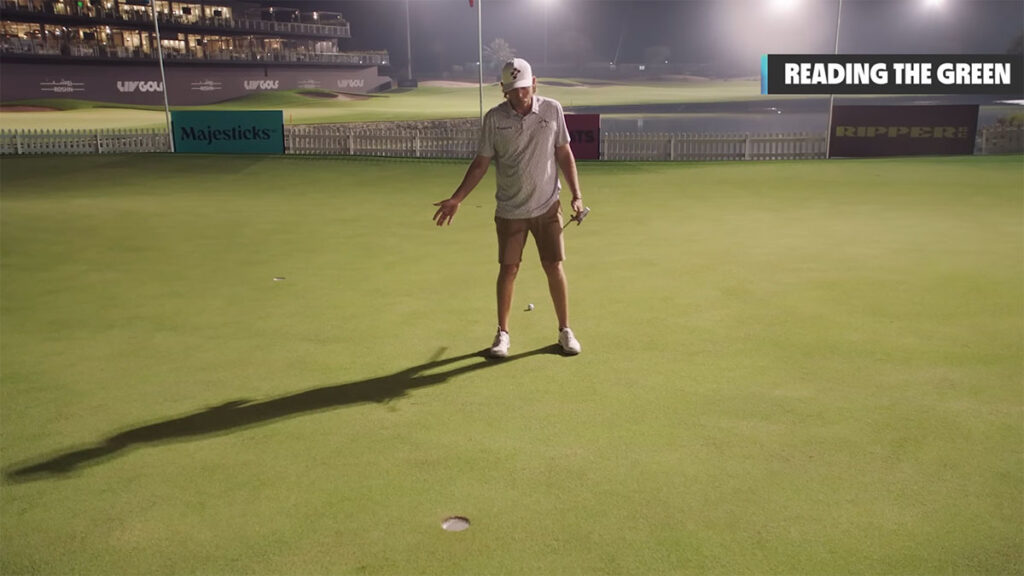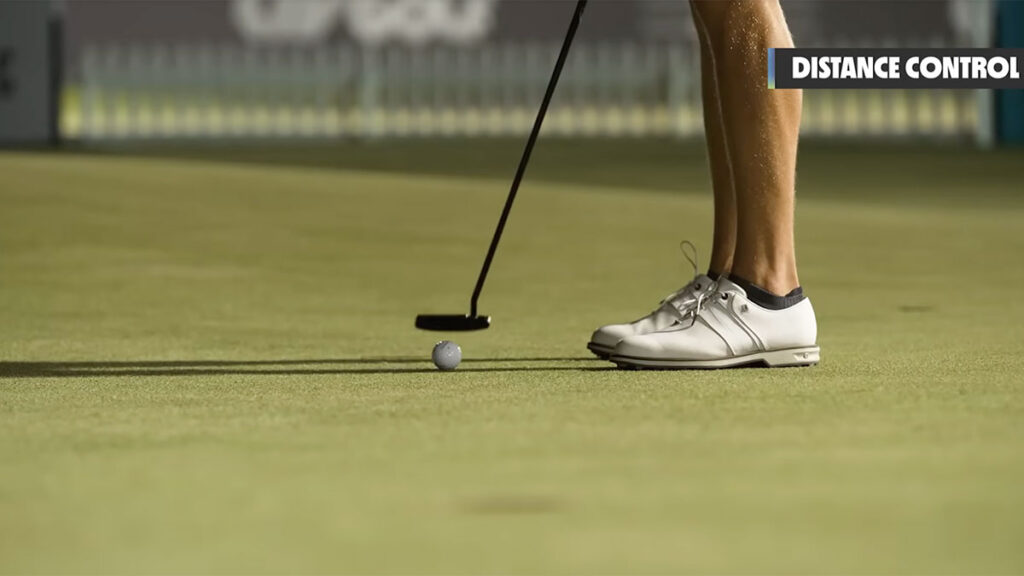When it comes to judging the break in a putt, don’t rely just on your eyes.
Reading greens is tricky. There are a few different methods out there now to help you judge the break, whereas it used to always be left up to your eyes. I like to do a little bit of mix and match. I like to use my feet – as is used with the renowned AimPoint method – as well as read it with my eyes. I think walking around the hole is another really important step to getting the correct read – just feeling the slope on the ground, whether you’re walking uphill or downhill. I’m a firm believer you need to be putting well to win golf tournaments. I think putting can also save you in a bad ball-striking day or week. Tour pros like me can still make a week out of nothing with some solid putting, while amateurs can keep themselves in the hunt for that monthly medal. It’s why putting is something I always work on, regardless of how well I’m stroking it. You should, too. Let me show you how I go about it.

1. THESE FEET WERE MADE FOR READING
I think reading the green can sometimes be a bit of personal preference. A lot of the guys will walk around the putt and see the putt from both directions. They’ll generally get on the side of it. Not a lot of guys use their feet. That’s still a relatively new technique in the game, I guess, but it’s something I’ve been learning now for the past seven or eight years and it’s helped me a lot, particularly on those 10 to 15-foot putts and in. I think this method really gives you a good idea of where the ball’s going, particularly on straight putts where a lot of good players really look for break when there isn’t any. They want to see the ball go in a certain side of the hole, whereas we probably have more straight putts than you think. Because of this, I like to read most of my putts with my feet. First, I’ll walk around the hole, feel if it’s uphill or downhill, and then I’ll straddle the putt (stand between ball and hole with my feet apart, being careful not to stand right on my line) and feel which way the slope is going. I generally straddle the putt two or three times in different positions between my ball and the hole to confirm the overall movement in the putt and if the severity of the slope changes at any point.

How does this work, you might ask? By standing on the line of my putt, I’m basically feeling where the weight is on my feet. If you have more weight on your right-hand side (right foot), you know that’s the direction the putt will break. If your weight is more on your left foot, the ball will go left. The more weight you have on a particular side, the more the ball is going to curve in that direction. It may take some practice but you can get this down to a pretty fine art. When I’m comfortable with what I’ve felt in my feet, I’ll then get behind my ball, pick my target where I want to aim and go.
YOUR HOMEWORK: For the amateur, an easy thought you often hear is: if it were to rain a lot on the green, which direction would the water run off? That’s a pretty old-school visualisation tip that definitely works but I think, as you get closer to the hole, it takes a little bit of practice and imagination to get right.
Another thing to think about is the way that the grass is growing. For me, I don’t read too much into if it’s left or right. I’d rather see if it’s going to affect the pace of the putt. So, if the green looks really shiny from behind your ball, generally that means it’s down grain. If it looks a bit darker, then you’re probably putting into the grain. So, if it’s shiny, the ball will roll out a little bit more. If it’s into the grain, it’ll be a little bit slower and you’re going to have to hit the ball a little bit harder, and that’s something that takes a lot of getting used to. But again, practice is the only way you’re going to get away with that. Remember, the pace of your putt – and how hard you hit it – will play a role in how sharply it breaks, so make sure you allow for either scenario when you aim.

2. YOUR BACKSWING LENGTH, NOT SPEED, DICTATES DISTANCE
Distance control of a putt is really important, particularly on those longer putts. We all have them – monster efforts outside 40 or 50 feet. They can get a little bit tricky coming up and over something or downhill. Distance for me is really all controlled in the backswing. I like to maintain my tempo – whether it’s a three-foot putt or a 100-foot bomb, I like to keep that tempo the same. All that’s really changing is the length of my backswing and then just hitting the ball, and just letting the putter naturally fall into the ball and then letting it naturally stop at the end of the stroke. There’s no acceleration for longer putts. There’s no deceleration for shorter putts. My tempo remains the same and all I’m changing is the length of backswing.

It’s something that I spend a lot of time on, particularly when I’m at the venue at the start of the week. I’ll probably hit a lot more longer putts here at the start of the week than I would at home practising.
YOUR HOMEWORK: Experimenting with your stroke length on different length putts before you tee off can save you a lot of shots as well. Like I said, we all have them. We all hit bad shots, and generally if you can get those down in two, you’ve made something up on the field. Remember to include shorter putts too. On these, you’re not taking the putter back really slow. You’re taking the putter back the same speed (think tempo) as you would a 100-foot putt. The length of your backswing is just shorter. Master this from all distances and it will get easier the more you work on it.
CAM’S QUICK TIP FOR LAG PUTTING
Lag putting for me is a little bit different to a lot of players, too. A lot of guys will take three or four practice swings to try to get a feel for the putt and how hard they should stroke it, whereas I don’t really take a practice swing. I’d rather just look at the hole and visualise the ball going in the hole – or somewhere around the hole for a nice tap-in – and then apply the stroke I feel matches that visualisation. Try not taking a practice stroke and see if you get closer to the hole with what you see in your mind. You might be surprised with the end result.
• WATCH NOW: Exclusive to the LIV Golf Plus app, get insights on how to improve your game from some of the best players in the world, including Cam Smith, Bryson DeChambeau, Graeme McDowell, Bubba Watson, Talor Gooch, Ian Poulter and more. https://www.livgolf.com/app



